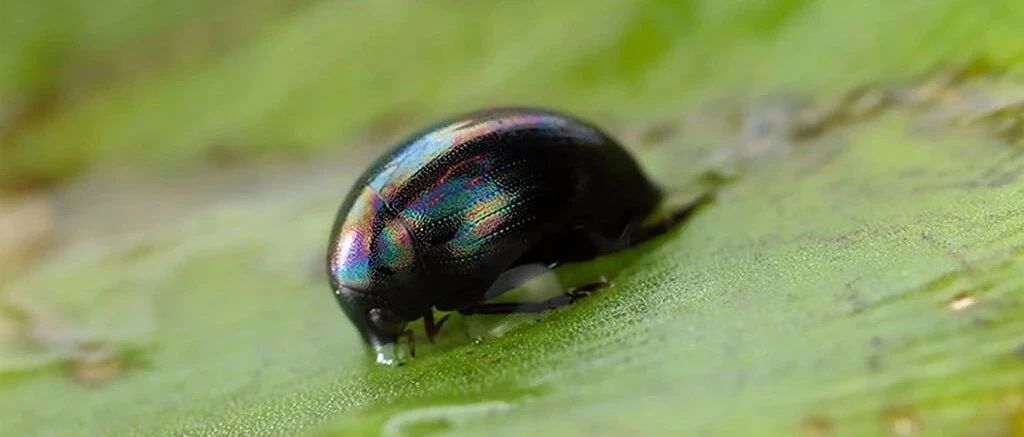
Look, that beetle has escaped from the frog and chrysanthemum!
Pass through the intestines and try to escape.
A small beetle appeared in front of (Pelophylax nigromaculata), a black-spotted side-fold frog. Almost in the blink of an eye, the bug was swallowed by the predator in front of it.
generally speaking, prey's infestation comes to an end when it is swallowed by a predator-but here, the best part has just begun. After about two hours, the tenacious beetle managed to get out of the frog's belly-it was excreted with its feces, but it was still alive.
(4x playback | Sugiura Shinji)
escape through the intestine: not by fluke, but by effort
in the above story, the protagonist who survived tenaciously through the intestine is an aquatic beetle called the fusiform flat tooth beetle (Regimbartia attenuata). Shinji Sugura, an entomology researcher at Kobe University, found their special survival skills in the experiment.
To inspire fashion and to show your preference to inspired style, you need plus size wedding dress rental. Our stylish options are gentle on your pocket.
although these beetles are easily swallowed by frogs, more than 90% of the individuals swallowed can pass through the frog's digestive tract within six hours and stimulate the frog to defecate, eventually escaping alive through the cloacal hole. Of all the beetles that successfully escaped through the intestines, 94.4% survived for at least two weeks.
(the beetle Regimbartia attenuata | Sugiura Shinji)
) before that, some animals have been found to survive through the intestines of predators. For example, about 15% of flea snail (Tornatellides boeningi) will survive after being swallowed and pulled out by birds. But the example of beetle escape is quite different from that of these snails: the latter can only be said to be a passive fluke, while the former is the result of "active effort".
in the experiment, the researchers artificially glued the legs of some beetles with wax so that they could not move freely. As a result, all the restricted beetles were killed after being swallowed, and no insects survived. The remains of the dead beetles were expelled by the frogs more than 24 hours later, while the surviving beetles usually passed through the frog's intestines within six hours, with a record of as little as six minutes. All this information shows that taking the initiative to find a way out is the key to the beetles' survival.
this is the first time that scientists have recorded a case in which prey actively escaped through the "back door" through the intestines of predators, and these "active escape" beetles have a significantly higher survival rate than those who "passively survived".
in addition to actively swimming in the digestive tract, the beetle also has a hard exoskeleton and can store bubbles under the sheath wing for its own breathing, which should also increase their chances of survival.
there are also worms that choose to "walk through the front door"
in previous studies, Shinji Sugura and his colleague Takuya Sato have also found that beetles that can escape from the "front door"-(Pheropsophus jessoensis) can stimulate predators to vomit and escape after being swallowed by toads.
(under stimulation, the toad spits out the swallowed beetle | Shinji Sugiura and Takuya Sato)
can do this, and the fart beetle relies on the blessing of chemical weapons. Normally, these beetles store hydroquinone and hydrogen peroxide in different "compartments" of the body. When in danger, they mix the two substances and, under the catalysis of enzymes, produce irritating "chemical weapons" p-benzoquinone. Hydrogen peroxide decomposes to produce oxygen to provide jet power. At the same time, the chemical reaction exothermic will also heat the liquid to a high temperature to increase killing, even reaching 100 ℃. After swallowing the beetles, the glowing chemical weapons burst into the stomach of the toad-not enough to kill predators, but to stimulate them to spit out their prey.
experiments show that 107 minutes after swallowing fart beetles, 43% of toads spit out their prey. All the 16 beetles spit out by toads were still alive, of which 15 survived for at least two weeks and one even lived for more than 18 months.
as for the frogs and toads that swallowed these beetles, their inner feelings are probably quite regretful.
PS: after watching this, on the one hand, I think the entomology researcher is really an interesting person, on the other hand, I think the scene of beetle escape is really good for Shawshank's redemption